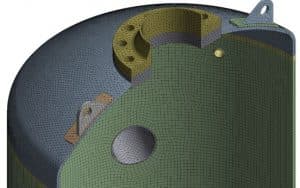Design-by-Analysis
BanuMusa R&D specializes in “design-by-analysis” pressure vessel work following ASME Section VIII, Div. 2 (BPVC) and Nuclear Quality Assurance (NQA-1) Certification codes.
Design-by-Analysis is a process used in many industries to design industrial equipment. Nearly 100 years ago, ASME issued the Boiler and Pressure Vessel Code (BPVC) design guidelines to enhance industrial safety. Today, ASME VIII is the most widely used pressure vessel design guideline. It has 3 sections, each with It is related to specific applications and methods.
In ASME VIII, there are two complementary assessment techniques:
- Design by Rule
- Design by Analysis (DBA)

What is needed in the design-by-analysis from ASME VIII Div. II?
For some reasons, design-by-rule may not be appropriate for structural design and evaluation, that is:
- Comprehensive fatigue calculations are essential.
- Geometry is often unconventional.
- The design has properties that cause stress concentration in the structure.
- In addition to pressure, the structure is subject to other loads.
In general, with design-by-analysis, several cases can be considered in the pressure vessel design:
- Design requirements to avoid plastic breakdown
- Design requirements to prevent local breakdown

- Design requirements to avoid buckling
- Numerical simulation requirements for the pressure vessels design using the finite element method (FEM)
- Material modeling requirements in the FEM
- Thermal analysis of pressure vessels
- Creep-fatigue design requirements
- Evaluation by failure method
- Design of pressure vessels with instructions EN 13445 and PD 5500
- Relationship between ASME VIII-Div. II and API 579-1 / ASME FFS-1 Level 3 in the structural life management process
- Design optimization to reduce material use and production costs
- Estimate the external loading capacity of the nozzle
BanuMusa R&D applied the following codes
- ASME BPVC Section VIII, Div. I, Rules for the Construction of Pressure Vessels
- ASME BPVC Section VIII, Div. II, Alternative Rules
- ASME BPVC Section VIII, Div. III, Alternative Rules for Construction of High-Pressure Vessels
- ASME Pressure Vessels for Human Occupancy (PVHO)
- ASME, Section X, “Fiber Reinforced Plastic Pressure Vessels”
- ASCE 4-98 and ASCE 7-02
- AISI N690
- ABS Underwater Vehicles, Systems & Hyperbaric Facilities
- API 579 / ASME FFS-1, Fitness for Service
Some consulting projects by BanuMusa R&D
- Thermal-stress analysis of heat exchangers,
- stress and fatigue analysis of large-diameter vessels,
- Finite element analyses of vessels subjected to sloshing, seismic and added-mass effects,
- Lifting and transportation analyses and
- Transient thermal-fatigue of thick-walled tanks.
- Buckling analysis of pressure vessels
- Failure, fracture & damage analysis of pressure vessels
- Stability and structural analysis of submersible vehicles
- Level 3 FFS assessment of spherical pressure vessel
- Level 3 FFS assessment of a K.O.D with wall thinning
- Explosion and impact analysis of pressure vessels
Abaqus and Ansys are mostly used for finite element analysis.
Call for free FEA/CFD consulting.













